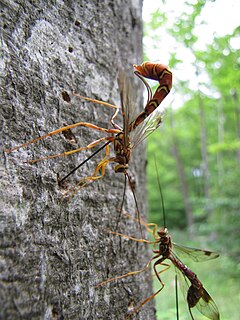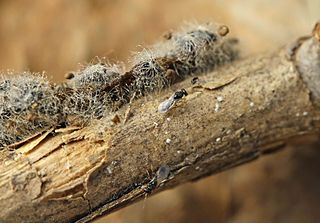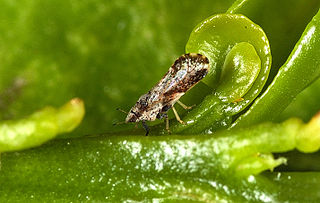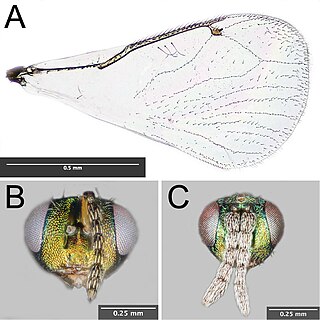
Whiteflies are Hemipterans that typically feed on the undersides of plant leaves. They comprise the family Aleyrodidae, the only family in the superfamily Aleyrodoidea. More than 1550 species have been described.

The silverleaf whitefly is one of several species of whitefly that are currently important agricultural pests. A review in 2011 concluded that the silverleaf whitefly is actually a species complex containing at least 24 morphologically indistinguishable species.

Papilio demoleus is a common and widespread swallowtail butterfly. The butterfly is also known as the lime butterfly, lemon butterfly, lime swallowtail, and chequered swallowtail. These common names refer to their host plants, which are usually citrus species such as the cultivated lime. Unlike most swallowtail butterflies, it does not have a prominent tail. The butterfly is a pest and invasive species, found from Asia to Australia. The butterfly has spread to Hispaniola island in the Western Hemisphere,

Parasitoid wasps are a large group of hymenopteran superfamilies, with all but the wood wasps (Orussoidea) being in the wasp-waisted Apocrita. As parasitoids, they lay their eggs on or in the bodies of other arthropods, sooner or later causing the death of these hosts. Different species specialise in hosts from different insect orders, most often Lepidoptera, though some select beetles, flies, or bugs; the spider wasps (Pompilidae) exclusively attack spiders.

Dryinidae is a cosmopolitan family of solitary wasps. Dryinidae comes from the Greek. Latreille named this family because the first species was collected in an Oak plant in Spain. The larvae are parasitoids of the nymphs and adults of Auchenorrhyncha (Hemiptera). Dryinidae comprises approximately 1800 described species, distributed in 15 subfamilies and 50 genera.
Delphastus pusillus is a small ladybird beetle which preys on all species and stages of whitefly, but prefers eggs and nymphs. The adults are small, shiny, black beetles. Newly emerged adults are pale-brown to almost white. They eventually turn black with a brown head. The eggs are 0.2 mm long, clear and twice as long as they are wide. The elongate larvae are pale yellow.

Encarsia formosa is a species of chalcidoid wasp and a well known parasitoid of greenhouse whitefly, one of the first to be used commercially for biological pest control, from the 1920s. They can use at least 15 species of whitefly as a host, including Bemisia tabaci and Aleyrodes proletella.

A wasp is any insect of the order Hymenoptera and suborder Apocrita that is neither a bee nor an ant. The Apocrita have a common evolutionary ancestor and form a clade; wasps as a group do not form a clade, but are paraphyletic with respect to bees and ants.
Baeoentedon is a genus of hymenopteran insects of the family Eulophidae, they are parasitoids of whitefly from the family Aleyrodidae which are found on trees of the genus Ficus. They have been recorded from Australia, China, India, Indonesia and Florida. A fifth species, Baeoentodon farazi, was described from Karnataka, India, in 2017.

Euplectrus is a genus of hymenopteran insects of the family Eulophidae.

Leptocybe invasa, the blue gum chalcid wasp or eucalyptus gall wasp, is a chalcid wasp which is the only species in the monotypic genus Leptocybe in the subfamily Tetrastichinae, of the family Eulophidae. It is a gall wasp which causes the formation of galls on a number of species of Eucalyptus, it was described in 2004 after galls were found in river red gums in the Mediterranean and Middle East and has since been found to be a widespread species where its host trees are planted. It is indigenous to Australia.

Aleurocanthus woglumi is a species of whitefly in the family Aleyrodidae. It is a pest of citrus crops, and is commonly known as the citrus blackfly because of its slate-blue colour. It originated in Asia, but has spread to other parts of the world. The parasitic wasps, Encarsia perplexa and Amitus hesperidum can help control the pest.

Encarsia perplexa is a tiny parasitic wasp, a parasitoid of the citrus blackfly, Aleurocanthus woglumi, which is a global pest of citrus trees. It was originally misidentified as Encarsia opulenta, but was recorded as a new species in 1998. It is a native of Asia but has been introduced to many other parts of the world as a means of controlling the citrus blackfly.

Encarsia is a large genus of minute parasitic wasps of the family Aphelinidae. The genus is very diverse with currently about 400 described species and worldwide distribution. The number of existing species is expected to be several times higher because many species are still undescribed. Encarsia is a very complex genus, with specimens showing both inter- and intra-specific variations, making morphological classification difficult.

The Asian citrus psyllid, Diaphorina citri, is a sap-sucking, hemipteran bug in the family Liviidae. It is an important pest of citrus, as it is one of only two confirmed vectors of the serious citrus greening disease. It is widely distributed in southern Asia and has spread to other citrus growing regions.
Ablerus is a genus of chalcid wasps belonging to the family Aphelinidae. The genus was created by the American entomologist Leland Ossian Howard in 1894 for the species named in that year by William Harris Ashmead as Centrodora clisiocampae. The genus Azotus was synonymized with Ablerus by Alexandre Arsène Girault in 1913 and Hyatt synonymized Myocnemella with Ablerus in 1994, leaving Ablerus as the sole genus within the subfamily Azotinae. These tiny wasps are normally hyperparasitoids and are associated with the Aleyrodidae and Coccoidea as well as the eggs of a variety of other insects. Overall there are over 90 species of Ablerus.
Encarsia inaron is a parasitoid wasp used in the control of ash whitefly, Siphoninus phillyreae. The ash whitefly is an insect from Europe that feeds on the sap of plants, and which has become a pest in North America. E. inaron was acquired from Italy and Israel and brought to California in 1989.

Tamarixia radiata, the Asian citrus cyllid parasitoid, is an hymenopteran wasp from the family Eulophidae which was discovered in the 1920s in the area of northwestern India (Punjab), now Pakistan. It is a parasitoid of the Asian citrus psyllid, an economically important pest of citrus crops around the world and a vector for Citrus greening disease.

Euderus set, the crypt-keeper wasp, is a tiny chalcid wasp from the family Eulophidae from the south-eastern United States, described in 2017. It is a parasitoid of the gall wasp Bassettia pallida, and the description of its life cycle attracted widespread publicity.

Aleurocanthus spiniferus, the citrus spiny whitefly, is an important pest of citrus and tea plants. They are part of the order Hemiptera, and the family Aleyrodidae, where more than 1550 species have been described. A. spiniferus is indigenous to parts of tropical Asia, where it was first discovered in Japan. Since its discovery, it has now spread to numerous continents including Africa, Australia, America, Pacific Islands and Italy. Wherever it is found, it has become a highly destructive pest. Two populations of A. spiniferus have been found according to the plant or crop they infest: the citrus spiny whitefly, as well as the tea spiny whitefly.














